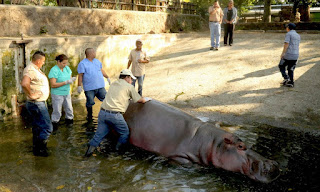No country for young hippopotamuses

A guest post by friend of the blog, Carlos Colorado Occasionally, something happens in El Salvador so horrendous that it provokes widespread indignation and soul-searching for the constantly-tested yet surprisingly tender Salvadoran psyche. Such has been the case with the news that Gustavito, the 15 year-old hippopotamus of the San Salvador zoo, was attacked by unknown aggressors with icepicks, metal bars and stones in the wee hours of Thursday, February 23. He died from his injuries this past Sunday evening. One of many editorials decrying the incident declared El Salvador “The land of eternal shame,” and questioned the moral fabric of a society wherein such an event occurs. The editorial lamented that “not only did Gustavito have to live like a Salvadoran, amid a great scarcity of resources, but he had to die murdered in the middle of that spiral of hatred, violence and blood that has accompanied us for almost four decades—first, the Civil War violence, the...

